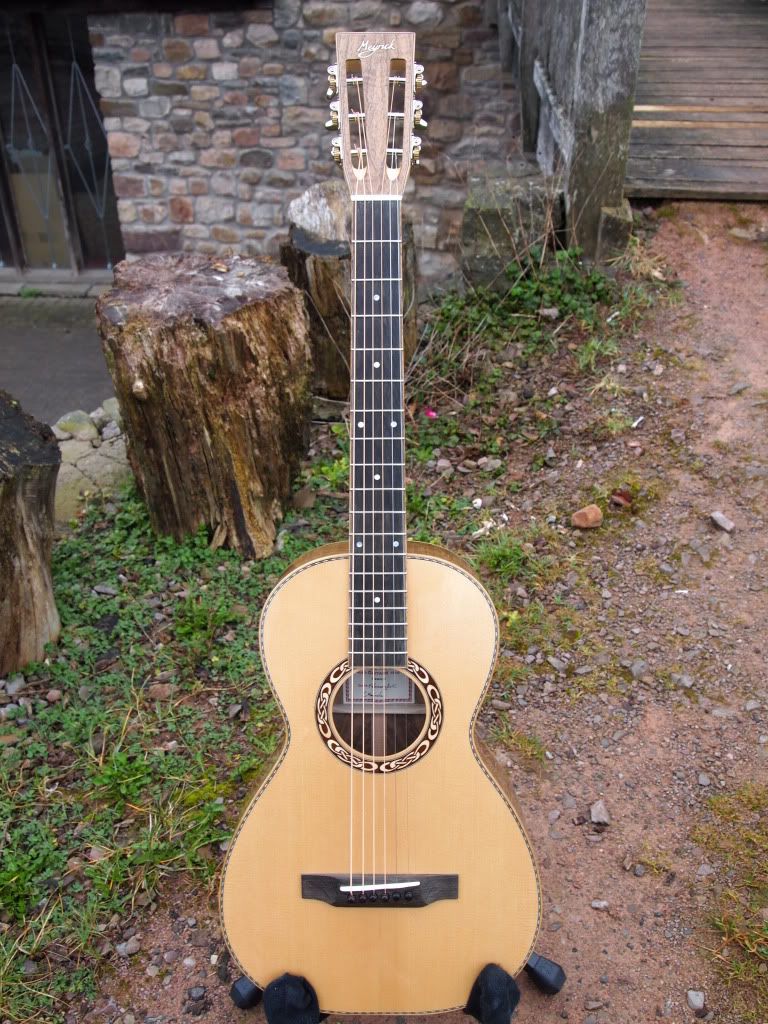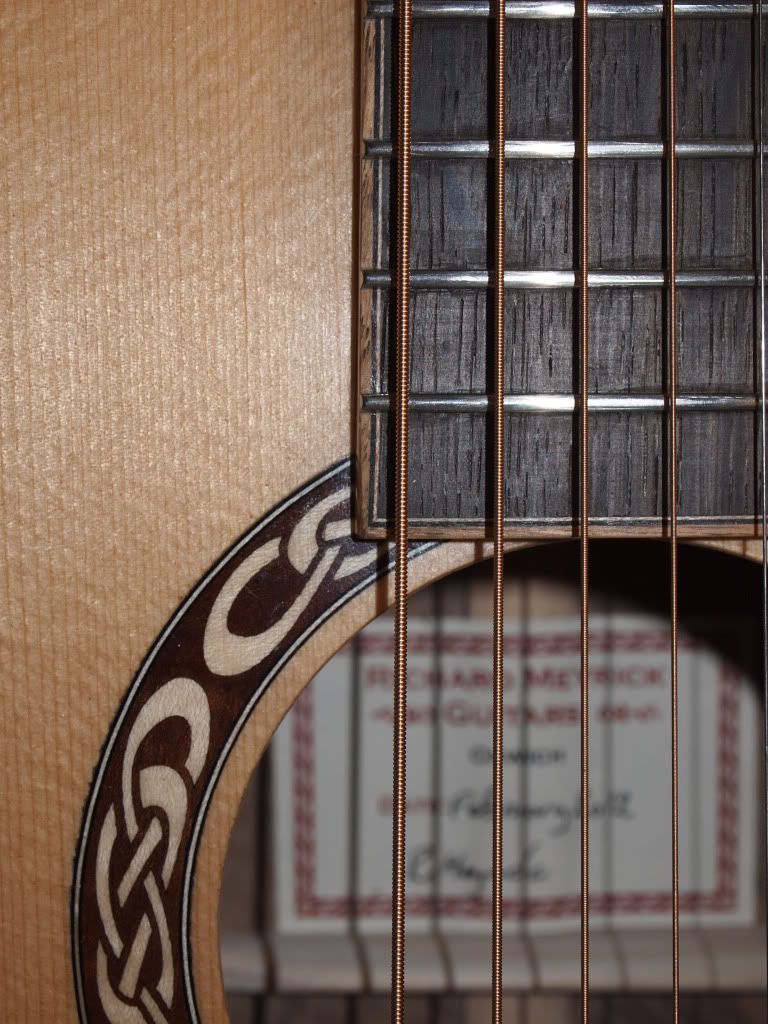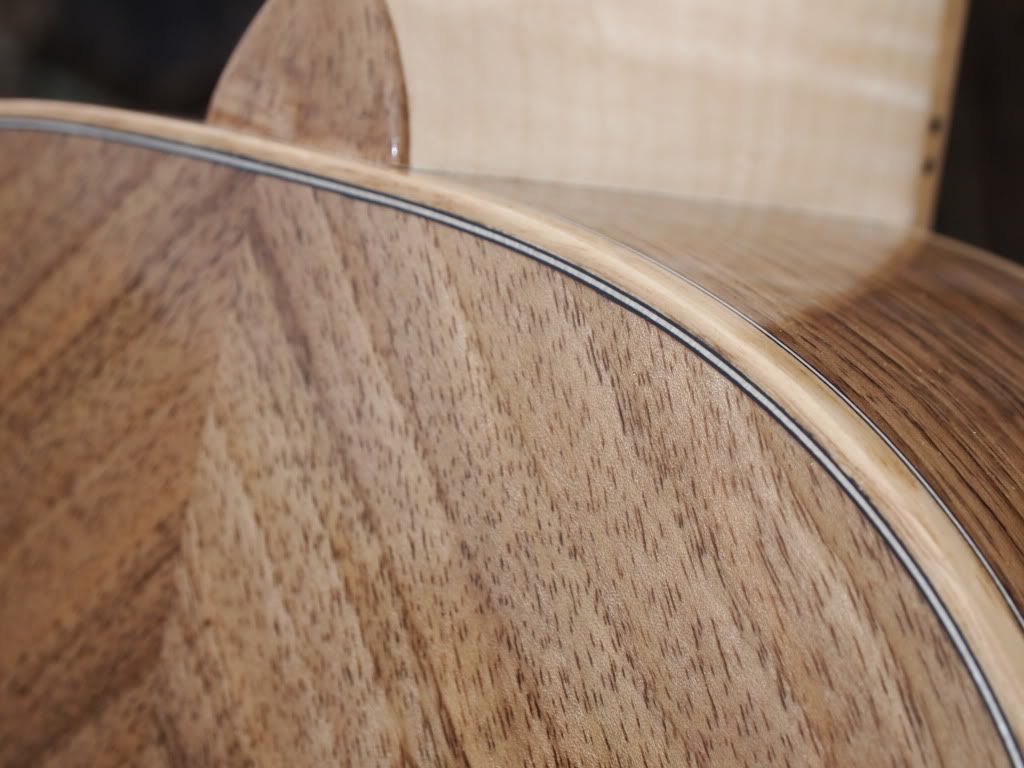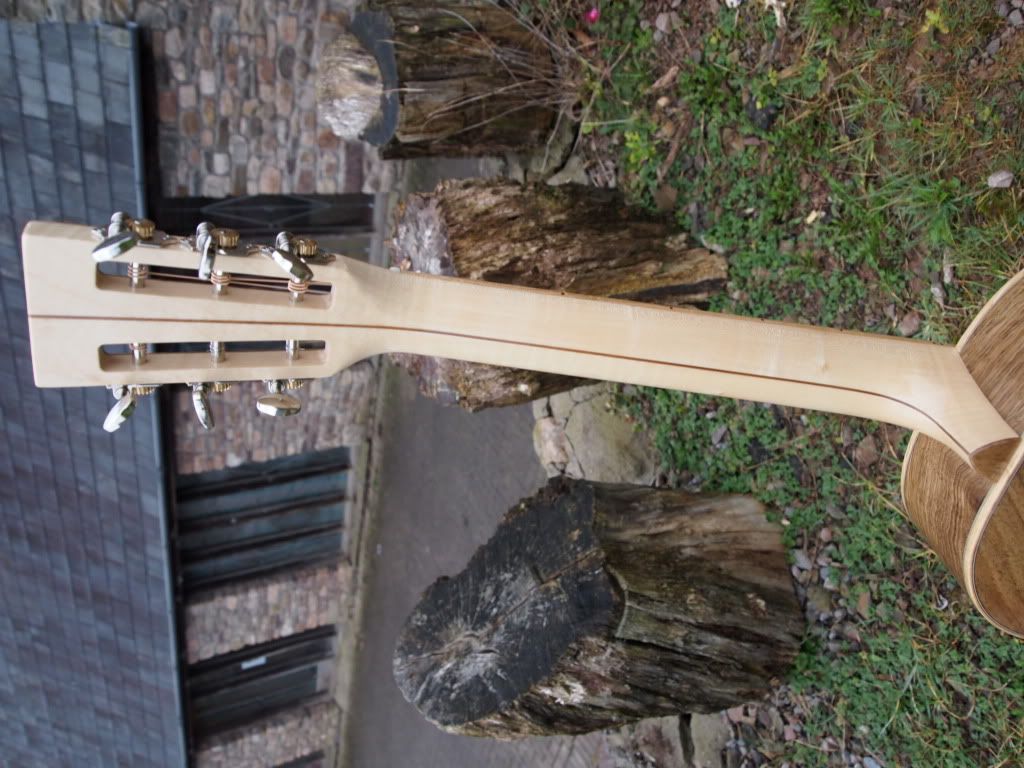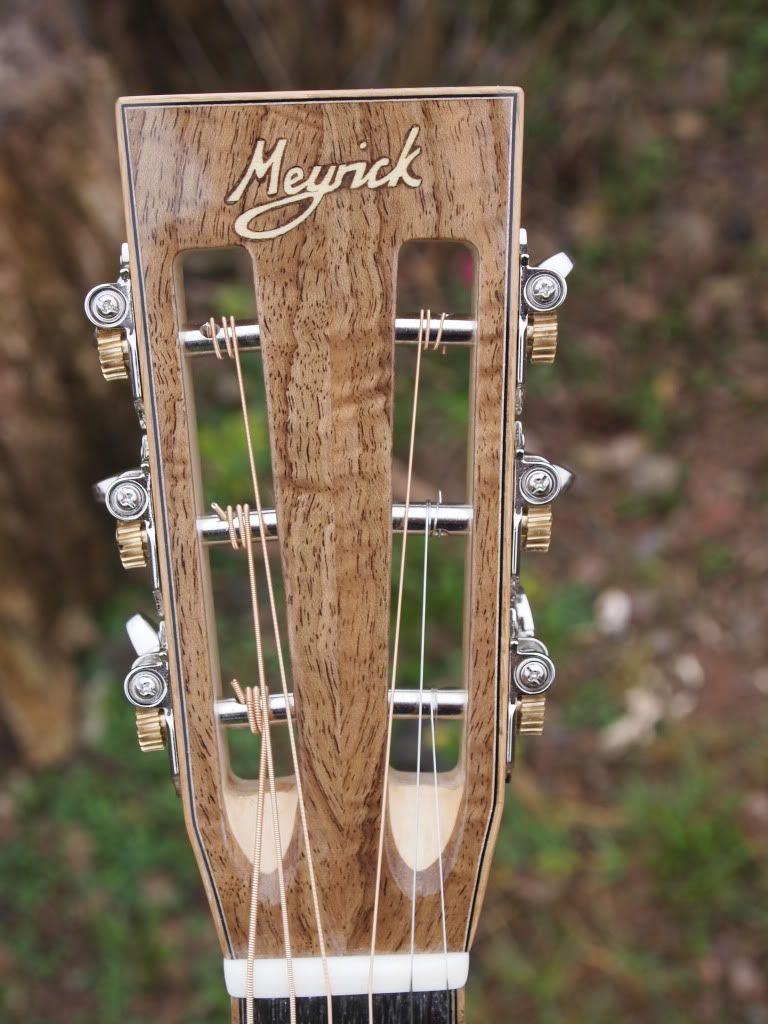Nothing guitary to show this time I'm afraid, I just want to show off my new tool/ gadget/ gizmo...
As some of you may know, last month I was catapaulted to the heights of fame and fortune by being interviewed for ITV Wales' 'Fishlocks Wales'. The theme for the programme was left handedness, as a left handed guitar maker I was asked to explain the differences between left and right handed guitars and why there aren't more left handed guitarists etc... One question stuck in my mind 'are there and left handed tools you use?' My answer was no; I get by pretty well with normal equipment, but one tool always catches me out and that's using my vernier calipers.
The are the only hand tool or measuring tool that have to be used right handed- otherwise they are upside down or back to front... not good for reading measurements to two decimal places so an internet search came up with these; the left handed calipers! shown with their dextrous sibling on the latest soundboard. I don't much like the digital readout and the fact you have to remember to turn the thing off everytime but hopefully it'll make life easier... not that it was particularly hard before... stupid whims!
More guitar making stuff next time I promise!
Wednesday, 6 June 2012
Sunday, 27 May 2012
Ok, another guitar in the making; a 21" scale length terz guitar. The idea of this guitar is that the pitch (and tension) of the strings is the same as if a normal guitar were capoed at the third fret but with a much smaller body.
Modelled after one of his own guitars, the customer has asked for a simple guitar with little ornamentation but using beautiful woods. Back, sides and neck are of mahogany, soundboard is bearclaw sitka spruce, binding is Koa, fingerbaord, bridge and head veneer are are Ziricote. Its going to make for a very nice (if tiny) guitar!
I have some nice comissions lined up this summer so watch this space...
Rich
Modelled after one of his own guitars, the customer has asked for a simple guitar with little ornamentation but using beautiful woods. Back, sides and neck are of mahogany, soundboard is bearclaw sitka spruce, binding is Koa, fingerbaord, bridge and head veneer are are Ziricote. Its going to make for a very nice (if tiny) guitar!
I have some nice comissions lined up this summer so watch this space...
Rich
Sunday, 18 March 2012
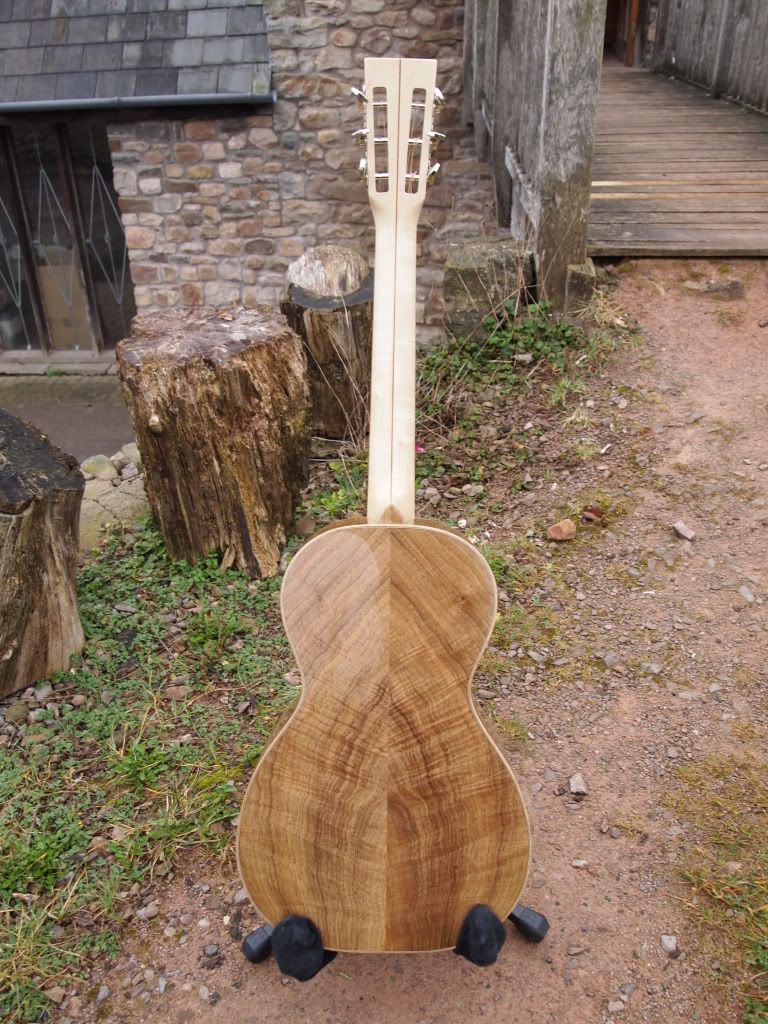
Ok, another guitar rolls off the factory production line! This Oxwich was picked up on Tuesday by its new happy owner. Its a lovely little thing with a big sound and heart. The brief, as I mentioned in the last post waaay back in october was to make a guitar using local, Welsh timber where possible. For the most part I succeded in sourcing Welsh woods, apart from the soundboard; softwood in Britain grows too fast to be of any use for instrument makers.
The real revelation in this build was using bog oak for the fingerboard and bridge. Bog oak has been sat in the ground for anywhere up to tens of thousands of years, the older it is, the closer to petrified it becomes, the piece I used on this guitar still felt very much like oak to work, just jet black but the beautiful medullary rays found in oak very much on show. I look forward to using bog oak again... If anymore gets ploughed up in the local fields.
Many Thanks to Stephanie Davies for laser cutting out the Rosette and my heastock logo in wood, it's turned out lovely!
Wednesday, 12 October 2011
I’ve been doing lots of repairs over the summer with plenty
of variety to keep things interesting;
replacing and refretting fingerboards, crack repairs, refinishing,
broken necks, loose braces, fitting bridges, new nuts, setups. I love the
variety of this job!
After all the repairs, it’s nice to get started on my latest
guitar. A commission for an Oxwich parlour guitar. The brief was to use as many
Welsh woods as possible so I’m using Walnut for the back/sides, Sycamore for
the neck, bog oak for the fingerboard and bridge, figured oak for the binding
and head veneer. The soundboard is from Prince of Wales island… Alaska. To
continue the welsh theme I’m inlaying a celtic knotwork rosette around the
soundhole.
In beekeeping news, all 3 hives are doing well, I collected
19 jars of honey from the largest hive, they’re all medicine and fed for the
winter so fingers crossed for a good year next year.
Free jar of honey for every guitar bought?
http://www.richardmeyrickguitars.co.uk/guitar%20repair%20%20and%20setup.html
http://www.richardmeyrickguitars.co.uk/guitar%20repair%20%20and%20setup.html
Sunday, 10 July 2011
Hi all, been busy doing lots of repairs and setups recently; working on enough floyd rose tremelos to last a lifetime as well as a couple of refrets (I don't just do refrets, although sometimes it seems like it). One was a classical guitar built in Nicuragua, its a nice instrument using local tonewoods; it'd be nice to have mahogany and Cocobolo growing in your back garden. The frets were a weak point of the guitar, stoned badly and made of a poor quality metal. The customer also wanted a slight camber on the fingerboard to help with those awkward classical positions. The next refret was to a tenor banjo, this refret was unusual in that the fingerboard was made of celluloid imitation mother of pearl (sometimes called mother of toilet seat) so a slightly different technique was called for. Instead of hammering in the frets as I would normally do with a wooden fingerboard I pressed them in using a caul and glued them in place using thin superglue, this stopped the fingerboard from cracking when installing the frets.
Another job, a bit out of the ordinary for me was to make a 'strat' style body with Humbucker- single coil- Humbucker routing and more exaggerated contouring. Lots of routing, sanding and rasping the outcome was very nice.
I'm off on Holiday for the next few weeks. If you are in the area at the end of the month the craft centre, where my workshop is, is showing a couple of my guitars as well as a work in progress (back, sides and front in pieces) as part of an exhibition, so if you are interested in seeing the inside of a guitar, some of my instruments and a nice cup of tea and cake then drop in.
Details on the website ( I think)
http://craftrenaissance.co.uk/
Another job, a bit out of the ordinary for me was to make a 'strat' style body with Humbucker- single coil- Humbucker routing and more exaggerated contouring. Lots of routing, sanding and rasping the outcome was very nice.
I'm off on Holiday for the next few weeks. If you are in the area at the end of the month the craft centre, where my workshop is, is showing a couple of my guitars as well as a work in progress (back, sides and front in pieces) as part of an exhibition, so if you are interested in seeing the inside of a guitar, some of my instruments and a nice cup of tea and cake then drop in.
Details on the website ( I think)
http://craftrenaissance.co.uk/
Sunday, 19 June 2011
Last week was very much 'new guitar week' both for me and for my first 'student' Richard who has been coming to my workshop a couple of times a week since the autumn to build himself a guitar. Whilst his aim at the beginning was to build himself a guitar which first and foremost had good tone with looks coming a distant second, he pretty quickly succumbed to pretty woods and shiny bits of shell. He's ended up with a guitar that looks great and sounds great too, the sound will continue to improve over the coming days, weeks and months as the wood loosens up and things settle down. The soundboard is European spruce. Back sides and neck are Claro Walnut. Binding and end fillet are Very figured Koa, fingerboard and front headstock veneer are ebony while the back veneer and bridge are burr oak and Indian Rosewood respectively. Rosette is abalone, the finish is Nitro cellulose over french polish.
Well done Richard and thanks for the canoe!
My new guitar is the first of a new body shape for me, my usual long scale length and a neck that joins the body at the 14th fret. Continuing the theme of naming my guitars after places I have fond memories of from summer holidays camping in West Wales this is the Rhossili model and will be on my website just as soon as I take some flashy photos of it. This particular guitar has a sitka spruce top, Indian rosewood back and sides, Koa binding ( that I managed to use before Richard nabbed the rest of it) reclaimed Mahogany neck Rosewood bridge and ebony fingerboard and headstock veneer. Its a bit of a departure for me as I usually build guitars suited for fingerpicking and this is a bit more of an all rounder, the harder sitka spruce usually favours plectrum playing but we'll see as the sound opens up.
Well done Richard and thanks for the canoe!
My new guitar is the first of a new body shape for me, my usual long scale length and a neck that joins the body at the 14th fret. Continuing the theme of naming my guitars after places I have fond memories of from summer holidays camping in West Wales this is the Rhossili model and will be on my website just as soon as I take some flashy photos of it. This particular guitar has a sitka spruce top, Indian rosewood back and sides, Koa binding ( that I managed to use before Richard nabbed the rest of it) reclaimed Mahogany neck Rosewood bridge and ebony fingerboard and headstock veneer. Its a bit of a departure for me as I usually build guitars suited for fingerpicking and this is a bit more of an all rounder, the harder sitka spruce usually favours plectrum playing but we'll see as the sound opens up.
Tuesday, 7 June 2011
I've had a bevvie of repairs in recently, so I thought I'd share them. First up is a Martin 000-18 reissue owned by nick from the excellent blues duo http://www.mikemarkeyandnickjones.com/index.htm with a loose bridge. Sometimes if a bridge is only a little loose on the corners, then a little glue can simply be injected and then clamped but this one was pretty loose so it had to come off. I use a variety of knives to get underneath the bridge. Its a tricky process, great care has to be taken not to slip the knife into the soft spruce of the soundboard or put a knife through the finish but after a few minutes and a loud 'pop' the bridge comes off.
Once the bridge was off, I scraped off the old glue residue from the bridge and soundboard. Its very important to have a very wood to wood glue join in order for the glue to perform. The bridge is one of the most critical glue joins on a guitar as it has to take the load of the strings. Once I glued the bridge on and left it clamped up for a day I spent some time at the buffing wheel to touch up a few lacquer cracks which had developedover time, then the guitar was restrung and sent out the door.
Once the bridge was off, I scraped off the old glue residue from the bridge and soundboard. Its very important to have a very wood to wood glue join in order for the glue to perform. The bridge is one of the most critical glue joins on a guitar as it has to take the load of the strings. Once I glued the bridge on and left it clamped up for a day I spent some time at the buffing wheel to touch up a few lacquer cracks which had developedover time, then the guitar was restrung and sent out the door.
Another job was to refret a very nice but much used parlour guitar made by Pete Howlett. The frets were first removed. I use a soldering iron to heat the fret and a little lemon oil to soften and lubricate the wire before using special pliers to gently ease the frets out. Once out the fingerboard was prepared, sanded flat and any chip outs repaired. Then the new frets were installed. This guitar has binding, so the ends of the tangs have to be removed so that only the top of the crown is on top of the binding. Once the frets were installed I then levelled and reprofiled them prior to restringing. After this the guitar was a real beauty to play and should be good for many years yet.
Subscribe to:
Posts (Atom)








